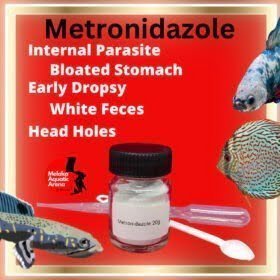

Metronidazole, also known by the trade name Flagyl, is a powerful antibiotic and antiprotozoal agent. While it is primarily used in human and veterinary medicine to treat a variety of infections, it also finds use in the world of fishkeeping. This article delves into the benefits, uses, and considerations of metronidazole for fish. {Benefits of Metronidazole}


Protozoan Parasites Treatment: Metronidazole is effective against certain protozoan parasites that affect fish, including Hexamita, which can cause hole-in-the-head disease, and Spironucleus, a related organism. Such infections can cause weight loss, white stringy feces, and lethargy in fish. { Benefits of Metronidazole }
Anaerobic Bacterial Infections: The drug is active against anaerobic bacteria, which thrive in environments without oxygen. In fish, these infections might manifest as internal or deep tissue infections. { Benefits of Metronidazole }
Combined Therapy: In some cases, metronidazole is used in combination with other treatments to enhance efficacy or treat co-infections. { Benefits of Metronidazole }
When treating fish with metronidazole, there are several methods of administration:
Bath Treatment: Dissolve the metronidazole in the tank water. This approach ensures that the medication is delivered to all the fish in the tank.
Oral Administration: For a more targeted treatment, metronidazole can be mixed with fish food. This ensures that the drug reaches the digestive tract where many protozoan parasites reside.
Injection: For very specific cases, and typically in larger fish species, injections might be used, though this is less common in the typical aquarium setting.
The dosage and duration of treatment will vary depending on the specific ailment being addressed, the species of fish, and other tank parameters. It’s always recommended to consult with a fish health specialist or veterinarian when determining the correct dosage and treatment duration.
While metronidazole is generally considered safe for fish when used at the recommended dosage, there can be potential side effects:
Neurological Effects: At high doses, metronidazole can cause neurological side effects in animals, so it’s crucial to ensure accurate dosing.
Impact on Biological Filter: There’s potential for metronidazole to impact beneficial bacteria in aquariums. This can disrupt the nitrogen cycle, leading to spikes in ammonia or nitrite, which are harmful to fish.
Interactions with Other Treatments: As with all medications, it’s important to be aware of any interactions metronidazole might have with other treatments being used in the tank.
When using metronidazole for bath treatment in fish, it’s important to ensure accurate dosing to achieve therapeutic levels without over-medicating. The following general guideline can be considered for metronidazole bath treatment:
Dosage for Bath Treatment:
Procedure:
Water Changes: Conduct partial water changes before each new dose is added, especially if the treatment extends over several days. This ensures the removal of any residual medication or waste products.
A Few Points to Consider:
Note: The provided information is based on general recommendations up to the last update in September 2021. Always refer to the manufacturer’s guidelines, if available, or consult with a veterinarian specialized in aquatic animals before administering any medication.
Oral administration of metronidazole is considered one of the most effective methods for treating certain internal infections in fish. When administered orally, the medication reaches the digestive tract, where many protozoan parasites reside. Here’s a general guideline for oral administration of metronidazole in fish:
Dosage for Oral Administration:
Procedure:
Considerations:
Safety Note:
Remember, while metronidazole is an effective treatment for certain diseases, it’s not a cure-all. Proper aquarium maintenance, good nutrition, and stress reduction are vital components of fish health.
Injecting fish with medications like metronidazole is a specialized procedure, generally reserved for larger fish and often carried out by fish health professionals or veterinarians. It’s rare for the average hobbyist to perform injections due to the associated risks and the expertise required.
Dosage for Injection:
The dosage for injecting metronidazole in fish can vary depending on the specific condition being treated, the species, and other factors. A general guideline might be:
Procedure:
Considerations:
Final Thoughts:
Injection is a potent method of delivering medication directly to a fish, bypassing issues related to ingestion or water treatment. However, due to the complexities and potential risks, it’s a method that should be approached with caution and ideally reserved for professionals. Proper aftercare and monitoring are essential, as complications can arise from the injection procedure itself.
Facebook | Instagram | Telegram | Youtube | Twitter | Posts |
How to Culture Tubifex Worms & Their Benefits for Fish If you're an aquarium enthusiast,…
A Comprehensive Guide to Shortfin Halfmoon Betta Standards Betta fish enthusiasts and breeders prize the…
Creating a top-quality Butterfly Pattern Show Betta requires a keen eye for detail, precise breeding,…
The black betta fish, a striking and exotic member of the betta family, is admired…
Outline Headings Sub-headings Introduction High-End Quality Red Show Betta Understanding the dark solid color…
Introduction: Astonishing phylogenetic relationships of mouth-brooding Betta The Betta genus, commonly known for the colorful…
This website uses cookies.